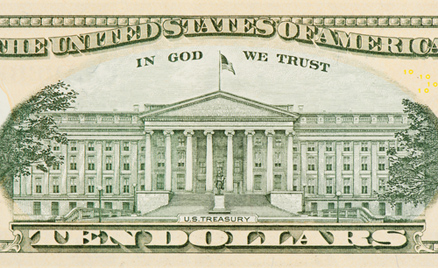Restoring fiscal sanity
 NorGal / Shutterstock.com
NorGal / Shutterstock.com
This series of Volume 3 response posts are written by former Miller Center fellows who offer their perspective on the topic of fiscal policy and how to best prepare the next president for the challenges of the first year. This series is coordinated and edited by Christy Ford Chapin, Assistant Professor of History at the University of Maryland, Baltimore County.
Historically, a president’s first year in office has been an auspicious time for getting major tax and spending bills through Congress. Soon after taking the oath of office, President Lyndon Johnson signed into law both a major tax cut and the Economic Opportunity Act of 1964, which launched an “unconditional war on poverty.” A few years later, President Richard Nixon, propelled by a burgeoning grassroots tax revolt that sought a more fair and efficient tax system, signed a major tax reform bill limiting more than 75 separate tax breaks. Similarly, President Ronald Reagan achieved a revolution in taxing and spending within months of taking office: in the summer of 1981, Congress passed both his Omnibus Budget Reconciliation and Economic Recovery and Tax Acts. Presidents Bill Clinton, George W. Bush, and Barack Obama all signed major tax bills during their first year in office.
The next president will encounter unprecedented fiscal challenges facing the nation. The national debt has soared to 74 percent of the nation’s Gross Domestic Product, the highest it has been since the World War II. Only by bringing the debt ratio closer to 40 percent—its average since 1965—can we expect to have real economic growth, increase national competitiveness, and improve the country’s overall financial health.
But the next president may not be as successful as previous leaders at achieving anything during his or her first year, especially in the area of tax and spending policy. Responsible fiscal policy will require bipartisan cooperation—something that has been in dangerously short supply in recent years. The toxic atmosphere on Capitol Hill and the resort to fiscal brinksmanship has increased economic insecurity, slowed recovery, and introduced a depressing pattern of fiscal cliffs, showdowns over the debt ceiling, and government shutdowns.
Breaking this pattern and restoring fiscal sanity is much easier said than done. It requires, as Jared Bernstein rightly notes, an “end to magical fiscal thinking.” Candidates must be honest with voters, even on the campaign trail. The remedy won’t be easy or popular. We can’t fix things simply by eliminating “waste, fraud, and abuse” in federal spending programs. Nor will it do simply to raise taxes on the very wealthy. The middle classes will have to bear some of the cost, either in the form of higher taxes or reductions in politically popular federal spending programs.
Unfortunately, history offers the next president few models of non-magical fiscal thinking. For decades, the Democrats have promised to ensure economic security and mobility to the majority of Americans while pledging to keep taxes low for all but the super rich. President Franklin Roosevelt, whose New Deal is rightly remembered as one of the high water marks of American liberalism, repeatedly rejected proposals to expand the federal income tax base into the ranks of the middle and working classes to fund his social and economic agenda. After World War II, liberals doubled down on this anti-tax logic, expanding and improving liberal economic and social security programs while promising low taxes for everybody but the wealthiest. For a time, this worked, but the economic collapse of the 1970s revealed the irreconcilable tension between low tax rates and a robust regime of middle-class economic security. The Democrats’ subsequent embrace of “fiscal responsibility” has done little to improve the party’s electoral appeal.
The ’70s economic crisis also allowed the GOP to become the “tax cut party.” Since then, the GOP has benefited from its reputation as what Wall Street Journal writer and early supply-side acolyte Jude Wanniski dubbed the “Santa Claus of Tax Reduction.” Most of today’s Republican officeholders have signed a pledge vowing never to raise taxes. The GOP’s anti-tax fundamentalism has survived and even intensified in the face of mounting evidence that the math simply doesn’t add up. If its candidates’ platforms are any indication, the GOP’s tax cut fever shows no sign of breaking any time soon.
The next president has to buck these trends in his or her first year. History suggests this is more likely to happen with a Democratic president than a Republican one. More than four decades ago, the GOP began to abandon its traditional commitment to balanced budgets and deficit reduction in favor of tax cuts, even if they are unpaid for. If anything, belief in the magic elixir of tax cuts has become more, rather than less, central to GOP governance.
At the same time, asymmetrical political polarization has made the possibility of compromise less likely. The suggestions offered in these papers to break through the Beltway gridlock, which range from a carbon tax to working with the states to control health care costs to naming a member of the opposite party to head up the Office of Management and Budget, may be overly sanguine in their assessments about politicians’ willingness to even consider compromise.
These ideas offered by this panel of experts are not guaranteed to work. Indeed, they are far more likely to fail. But, the next president will need to get creative if he or she wants to leave a lasting—and positive—fiscal legacy.
Molly Michelmore is an Associate Professor of History at Washington and Lee University in Lexington, Virginia. She received her B.A. from Amherst College and her Ph.D. in American History from the University of Michigan. A former Congressional staffer and Miller Center fellow, Michelmore’s first book, Tax and Spend: Welfare, Taxes and the Limits of American Liberalism, was published by the University of Pennsylvania Press.